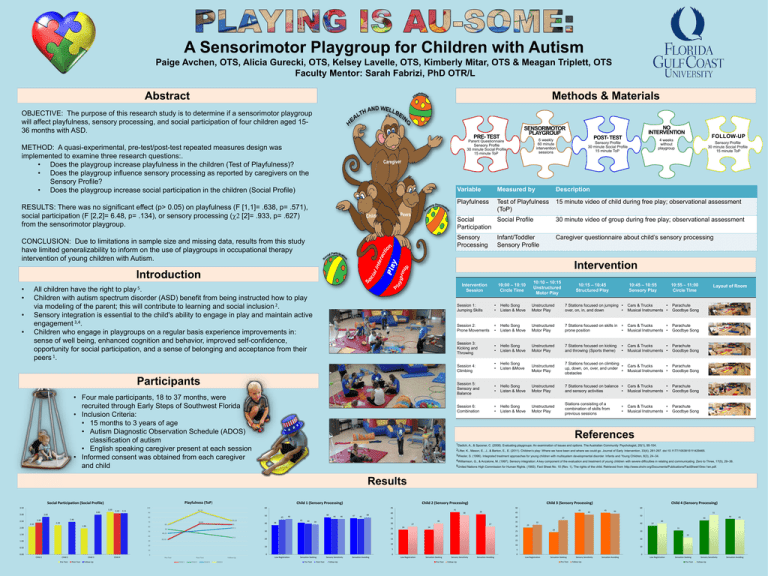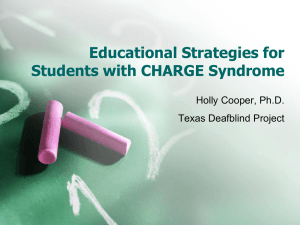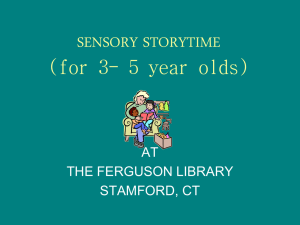A Sensorimotor Playgroup for Children with Autism
advertisement

A Sensorimotor Playgroup for Children with Autism Paige Avchen, OTS, Alicia Gurecki, OTS, Kelsey Lavelle, OTS, Kimberly Mitar, OTS & Meagan Triplett, OTS Faculty Mentor: Sarah Fabrizi, PhD OTR/L Abstract Methods & Materials OBJECTIVE: The purpose of this research study is to determine if a sensorimotor playgroup will affect playfulness, sensory processing, and social participation of four children aged 1536 months with ASD. PRE- TEST RESULTS: There was no significant effect (p> 0.05) on playfulness (F [1,1]= .638, p= .571), social participation (F [2,2]= 6.48, p= .134), or sensory processing ( [2]= .933, p= .627) from the sensorimotor playgroup. CONCLUSION: Due to limitations in sample size and missing data, results from this study have limited generalizability to inform on the use of playgroups in occupational therapy intervention of young children with Autism. Sensory Profile 30 minute Social Profile 15 minute ToP Measured by Description Playfulness Test of Playfulness (ToP) 15 minute video of child during free play; observational assessment Social Social Profile Participation 30 minute video of group during free play; observational assessment Sensory Processing Caregiver questionnaire about child’s sensory processing Infant/Toddler Sensory Profile • Four male participants, 18 to 37 months, were recruited through Early Steps of Southwest Florida • Inclusion Criteria: • 15 months to 3 years of age • Autism Diagnostic Observation Schedule (ADOS) classification of autism • English speaking caregiver present at each session • Informed consent was obtained from each caregiver and child 10:15 – 10:45 Structured Play 10:45 – 10:55 Sensory Play 10:55 – 11:00 Circle Time Session 1: Jumping Skills • • Hello Song Listen & Move Unstructured Motor Play 7 Stations focused on jumping • over, on, in, and down • Cars & Trucks • Musical Instruments • Parachute Goodbye Song Session 2: Prone Movements • • Hello Song Listen & Move Unstructured Motor Play 7 Stations focused on skills in prone position • • Cars & Trucks • Musical Instruments • Parachute Goodbye Song Session 3: Kicking and Throwing • • Hello Song Listen & Move Unstructured Motor Play 7 Stations focused on kicking and throwing (Sports theme) • • Cars & Trucks • Musical Instruments • Parachute Goodbye Song • • Hello Song Listen &Move Unstructured Motor Play 7 Stations focused on climbing • up, down, on, over, and under • obstacles Cars & Trucks • Musical Instruments • Parachute Goodbye Song Session 5: Sensory and Balance • • Hello Song Listen & Move Unstructured Motor Play 7 Stations focused on balance • and sensory activities • Cars & Trucks • Musical Instruments • Parachute Goodbye Song Session 6: Combination • • Hello Song Listen & Move Unstructured Motor Play Stations consisting of a combination of skills from previous sessions Cars & Trucks • Musical Instruments • Parachute Goodbye Song Session 4: Climbing Participants 10:10 – 10:15 Unstructured Motor Play 10:00 – 10:10 Circle Time Intervention Session All children have the right to Children with autism spectrum disorder (ASD) benefit from being instructed how to play via modeling of the parent; this will contribute to learning and social inclusion 2. Sensory integration is essential to the child's ability to engage in play and maintain active engagement 3,4. Children who engage in playgroups on a regular basis experience improvements in: sense of well being, enhanced cognition and behavior, improved self-confidence, opportunity for social participation, and a sense of belonging and acceptance from their peers 1. • 4 weeks without playgroup Sensory Profile 30 minute Social Profile 15 minute ToP Intervention play 5. • FOLLOW-UP Variable Introduction • • POST- TEST 6 weekly 60 minute intervention sessions Parent Questionnaire Sensory Profile 30 minute Social Profile 15 minute ToP METHOD: A quasi-experimental, pre-test/post-test repeated measures design was implemented to examine three research questions:. • Does the playgroup increase playfulness in the children (Test of Playfulness)? • Does the playgroup influence sensory processing as reported by caregivers on the Sensory Profile? • Does the playgroup increase social participation in the children (Social Profile) NO INTERVENTION SENSORIMOTOR PLAYGROUP • • Layout of Room References 1Dadich, A., & Spooner, C. (2008). Evaluating playgroups: An examination of issues and options. The Australian Community Psychologist, 20(1), 95-104. 2Lifter, K., Mason, E., J., & Barton, E., E. (2011). Children’s play: Where we have been and where we could go. Journal of Early Intervention, 33(4), 281-297. doi:10.1177/1053815111429465. 3Wieder, S. (1996). Integrated treatment approaches for young children with multisystem developmental disorder. Infants and Young Children, 8(3), 24–34. 4Williamson, G., & Anzalone, M. (1997). Sensory integration: A key component of the evaluation and treatment of young children with severe difficulties in relating and communicating. Zero to Three, 17(5), 29–36. 5United Nations High Commission for Human Rights. (1993). Fact Sheet No. 10 (Rev. 1), The rights of the child. Retrieved from http://www.ohchr.org/Documents/Publications/FactSheet10rev.1en.pdf. Results Playfulness (ToP) Social Participation (Social Profile) 3.50 3.20 3.00 3.00 2.83 3.11 90 50 2.46 2.40 70 2.20 2.10 65 60 1.50 30 38 40 46 47 46 30 37.5 33.33 Pre-Test Post-Test Follow-Up Child 4 24 27 30 24 20 15 Pre-Test Post-Test Child 1 Child 2 Follow-Up Child 3 Child 4 Pre-Test Post-Test Sensory Sensitivity Follow-Up Sensation Avoiding 46 45 40 32 40 29 37 31 24 30 22 20 10 5 0 0 Sensation Seeking 44 10 5 Low Registration 51 50 15 10 0 44 20 10 0 Child 3 35 27 43 45 37 25 10 Child 2 40 20 0.50 Child 1 45 30 20 0.00 39 35 25 60 45 30 39 46.25 40 1.00 41 40 46 48 57.5 55 50 46 73.33 66.66 65 1.96 2.00 45 48 38 40 Child 4 (Sensory Processing) Child 3 (Sensory Processing) 50 41 93.33 80 2.50 45 60 100 3.10 Child 2 (Sensory Processing) Child 1 (Sensory Processing) Low Registration Sensation Seeking Pre-Test Sensory Sensitivity Follow-Up Sensation Avoiding 0 Low Registration Sensation Seeking Pre-Test Sensory Sensitivity Follow-Up Sensation Avoiding Low Registration Sensation Seeking Pre-Test Sensory Sensitivity Follow-Up Sensation Avoiding









